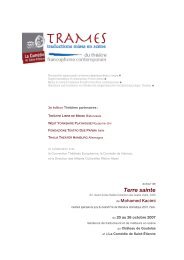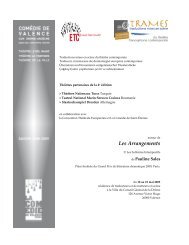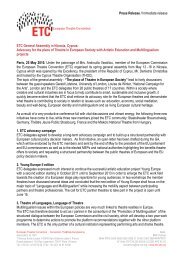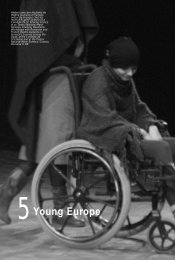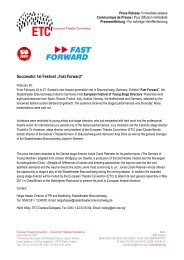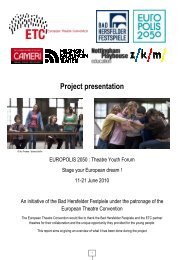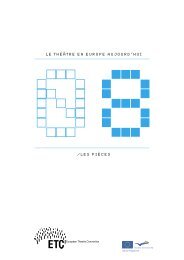Le théâtre en Europe aujourd'hui - European Theatre Convention
Le théâtre en Europe aujourd'hui - European Theatre Convention
Le théâtre en Europe aujourd'hui - European Theatre Convention
Create successful ePaper yourself
Turn your PDF publications into a flip-book with our unique Google optimized e-Paper software.
turkey<br />
> türkiye cumhuriyeti<br />
turquie<br />
+ info<br />
> www.etc-cte.org<br />
164<br />
><br />
ADDRESS/ADRESSE<br />
E: tcuc<strong>en</strong>oglu@yahoo.com<br />
W: www.sehirtiyatrolari.com/tuncer<br />
WORKS/ŒUVRES<br />
Chaos; The Teacher; Poor Wom<strong>en</strong>;<br />
Dead End; The File; Biga-1920; The<br />
Gamblers; Helicopter; Kemal The<br />
Thunder; Matrushka; The Visitor ;<br />
The Hat; The Painter; Neyz<strong>en</strong>; Red<br />
River; <strong>Theatre</strong>me; Sabahattin Ali;<br />
Gre<strong>en</strong> Night; If I Were a Poor Man;<br />
Che Guevara<br />
PREMIERE/CRÉATION<br />
Bursa Devlet Tiyatrosu (National<br />
<strong>Theatre</strong> of Bursa)<br />
DIRECTOR/METTEUR EN SCÈNE<br />
Ayse Emel Mesci<br />
TRANSLATIONS/TRADUCTIONS<br />
English/Anglais, Polish/Polonais,<br />
Russian/Russe, German/Allemand,<br />
Fr<strong>en</strong>ch/Français, Spanish/Espagnol,<br />
Georgian/Géorgi<strong>en</strong>, Bulgarian/<br />
Bulgare, Persian/Persan, Arabic/<br />
Arabe, Swedish/Suédois<br />
AWARDS/PRIX<br />
Russian Journalists’ Award/Prix des<br />
journalistes russes (2005)<br />
CHARACTERS/PERSONNAGES<br />
7 male/hommes<br />
5 female/femmes<br />
Tuncer Cüc<strong>en</strong>oglu 1944<br />
çıg<br />
the avalanche<br />
l’avalanche<br />
In fear of avalanches, a small village surrounded by mountains lives<br />
nine months out of twelve froz<strong>en</strong> in a deathly sil<strong>en</strong>ce. To protect the<br />
community, strict rules codify all acts. Marriage, sexual life and<br />
birth are planned according to a precise schedule. Noisy expressions<br />
of life are authorised only once the snows have melted and the<br />
danger has passed. In this context, a family finds itself confronted<br />
with the most dreaded of situations: just before the arrival of spring,<br />
a young woman is about to give birth prematurely. The village<br />
Council’s decision is categorical: to guarantee the community’s<br />
safety, the young woman must be eliminated. In reaction to the<br />
viol<strong>en</strong>ce and absurdity of this inhumane law, the young man seizes<br />
rifles and prev<strong>en</strong>ts the guards from taking his wife. Thanks to this<br />
act of resistance the young woman is able to give birth. The cry<br />
of the newborn child rings out like an imm<strong>en</strong>se ironic laugh. The<br />
avalanche doesn’t happ<strong>en</strong>. The final sc<strong>en</strong>e is a viol<strong>en</strong>t explosion<br />
of joy after the t<strong>en</strong>sion of the wait and the trial, a sort of ritual<br />
ceremony, hailing the arrival of spring and that of the first baby<br />
born of resistance and freedom. A known natural ph<strong>en</strong>om<strong>en</strong>on in<br />
some regions of eastern Anatolia, the avalanche provides the author<br />
with a symbolic situation that can be transposed to any context<br />
where political power oppresses the individual, as well as a poetic<br />
framework to express the quest for freedom and the virtues of<br />
resistance.<br />
Dans la crainte d’une avalanche, un petit village cerné de montagnes<br />
vit neuf mois sur douze figé dans un sil<strong>en</strong>ce de mort. Dans le but de<br />
protéger la communauté, des règles strictes codifi<strong>en</strong>t tous les actes<br />
de la vie. Mariage, vie sexuelle et accouchem<strong>en</strong>t sont planifiés selon<br />
un cal<strong>en</strong>drier précis. Ce n’est qu’après la fonte des neiges, lorsque<br />
le danger s’est éloigné, que les expressions bruyantes de la vie<br />
sont autorisées. C’est dans ce contexte qu’une famille se retrouve<br />
confrontée à la situation la plus redoutée : juste avant l’arrivée du<br />
printemps, la jeune femme est sur le point d’accoucher avant terme.<br />
<strong>Le</strong> conseil du village se réunit. <strong>Le</strong> verdict est formel : pour garantir<br />
la sécurité de la communauté, la jeune femme doit être éliminée.<br />
Devant la viol<strong>en</strong>ce et l’absurdité de cette loi inhumaine, le jeune<br />
homme s’empare de fusils et empêche les gardes d’emm<strong>en</strong>er sa<br />
femme. Cet acte de résistance permet à la jeune femme d’accoucher.<br />
<strong>Le</strong> cri du nouveau-né ret<strong>en</strong>tit comme un imm<strong>en</strong>se rire ironique.<br />
L’avalanche n’a pas eu lieu. <strong>Le</strong> final est une viol<strong>en</strong>te explosion<br />
de joie après la t<strong>en</strong>sion de l’att<strong>en</strong>te et du procès, une sorte de<br />
cérémonie rituelle, saluant l’arrivée du printemps et celle du premier<br />
bébé né de la résistance et de la liberté. Phénomène naturel connu<br />
dans certaines régions de l’Anatolie ori<strong>en</strong>tale, l’avalanche offre<br />
à l’auteur une situation symbolique, transposable dans n’importe<br />
quel contexte où le pouvoir politique opprime l’individu, ainsi qu’un<br />
cadre poétique pour exprimer la quête de liberté et les vertus de la<br />
résistance.




